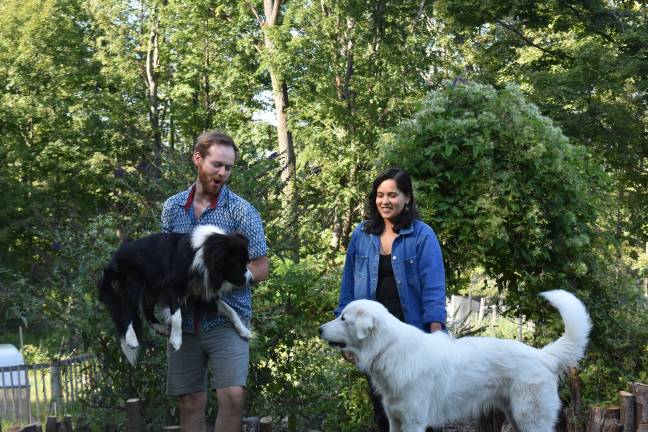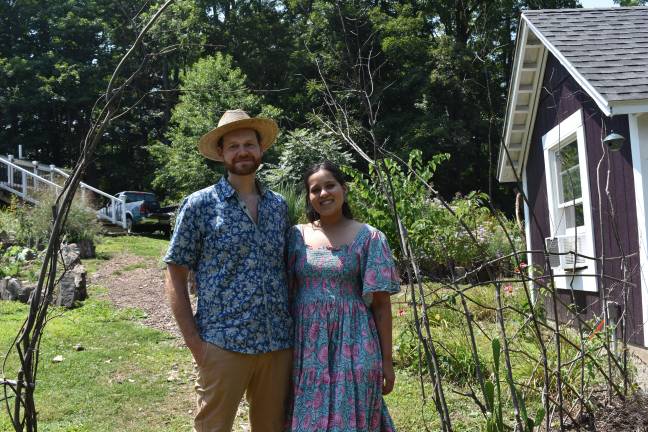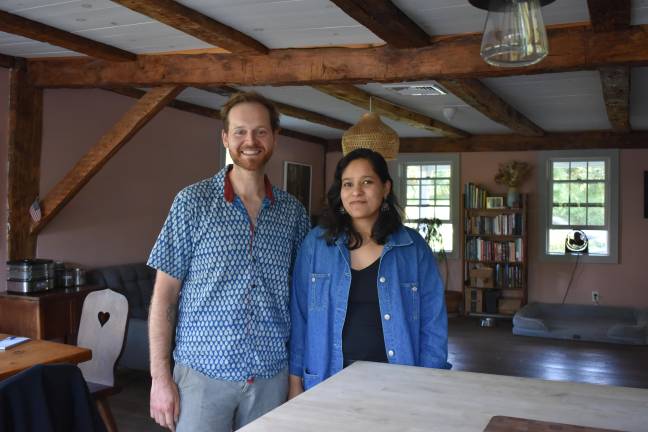‘The land wants to be visited’
On a quarter-acre micro-farm, a couple’s quest to bring back ancestral knowledge



When Patrick Scott and Soham Dhesi moved from Los Angeles to New York, they assumed they’d end up in an apartment, not on a 24-acre farm. But when they saw this forested property in Florida, NY with a Frankenstein 1740 farmhouse and massive barn, “we absolutely fell in love, and we could just see potential,” said Scott. They got to work, clearing a quarter acre of dying ash for a micro-farm that would not only feed but educate their neighbors.
For the first time in decades, the gates of this historic farm – whose Craft Barn was, they’ve learned, a popular shopping destination for tchotchkes and Birkenstocks in the 70s – are open wide once more.
Last I saw you was on Dirt’s Kitchen Garden Tour, which you won. You’ve since hosted a fermentation workshop and a shiitake log inoculation. Where’d you learn these skills?
P: We’re definitely not experts, but we’ve done a few of these things enough times now that we’re excited to share them with other people. What we’re hoping to inspire is a little more fearlessness in our community to try new things and to hopefully retain and rebuild some of the ancestral knowledge that we’ve always had, and to bring those things back into the foreground.
How’d you get into growing on this scale?
P: I did a permaculture design course online when I was living in Los Angeles. I already knew that I really wanted to grow food. I was doing a pretty radical garden in the front yard of a small apartment in Boyle Heights, which is East LA, and I had my eyes set on bigger spaces. It’s always been education for me, because I’m not going to be able to save the world myself, or mitigate climate change on my own. But if we can prove these theories, in the way we use systems to grow our food, then hopefully we can inspire a couple other people to do the same, and that is where you make a real impact.
Talk about your upbringing, Soham.
S: I grew up in Bangalore, now called Bengaluru, in India. I moved to the United States when I was 17, and that was the year I got my green card. Long story short, I moved by myself, and I lived with my relatives to do a year of high school in Sacramento, and then I went to went on to study architecture in Los Angeles, and then I did my masters in urban planning. So I’ve always been very city-oriented. The motivation though, for me to study both those fields was sustainability, climate change, so we have that commonality. The motivation of sort of trying to do a little bit more and feeling a little bit less helpless, it’s kind of a driving force here.
P: Even if it’s a workshop where you can make your own pickles. Pickles can be a slippery slope to taking a lot more control of your pantry.
Does it ever get exhausting, manning the farm in addition to your off-farm jobs?
P: I like working hard in things that are meaningful. I guess that was something that was really clicking for me as I built my garden. I was doing corporate work as an event producer in Los Angeles, and I would do a 10-hour day at the office, you know, with the LA traffic, and then I would stop at Home Depot on my way home and buy bags of soil and expand my garden and build raised beds. And I could just put hours into it, because it wasn’t laborious. It was work, but like, so feeding, right? I think all of us have felt that in our gardens, that it’s a joy to walk back outside and see who’s put out a new leaf. So I think I was just trying to listen to the parts of my life that didn’t feel like work. Where I could do hard work and not feel drained or exhausted by it.
How did you two meet?
P: Through an app, the way people our age meet. I kind of decided I was really looking for my person. I think I’d like, cosmically, really put myself out there. I’m a practicing Buddhist. I meant for this to happen insomuch that I was very happy to be alone forever, or meet the person that I was going to be with forever, but not to be with someone I wasn’t meant to be with forever, right? I was readily accepting of those two options.
S: You were chanting for it.
P: Yeah, I was chanting.
Literally chanting?
P: I chant a phrase from the Lotus Sutra in the mornings and evenings, and so my intention in mind was looking for my partner.
S: It’s funny because people use my name to chant.
P: I wasn’t using her name. That would have been weird.
Does Soham mean something?
S: It means you and I, the universe and I, we’re one and the same, in Sanskrit. Spiritually, we connected in a lot of ways.
P: A lot of the same things were always important to both of us, right? Of course, we like each other quite a lot, but also we care a lot about the same things. We care a lot about like, the human creature, I don’t know. Obviously it’s not our job to take care of him, but maybe it is a little bit and we feel we should just try to do the most good while we’re here.
Did you come to Buddhism in adulthood?<br /> P: Yeah, I was raised a Born Again Christian, and some of that stuff didn’t really make sense long term. So I always felt very spiritual, but I began having trouble really reckoning with the conventional idea of what God is. And the Buddhist interpretation of that is that we are what God is – like Soham’s name means I am what you are. This being-ness is Godness. That’s really what I believe Buddhism is, this practice of revealing your being-ness.
How did you get from Los Angeles to Florida, NY?
P: We were looking at land in California, but it’s very, very expensive, and you have to import the water. And that felt like a bad idea. It felt like not a smart place to grow food, just on a logical level. They do have places that have really excellent soil, undoubtedly, but they’re all importing the water, usually from the Colorado River and usually at the expense of lots of people downriver who kind of need that stuff, right? So it felt contradictory to even do it, not to mention the price. And so when we started looking a little further north, a little further north, we thought, if we’re going to have to leave Los Angeles altogether, why would we even stick to California? All my family is here, and it rains.
S: And, you know, even up north, like, all the way in Oregon, Washington, it’s still fire country. We knew that it was only going to get worse and worse, and I think that was another element – as things evolve, what’s a smart place to put down roots? And also have access to support? Because this is not a one or two person operation.
P: My uncle, my father, my mother, my brothers, my sister, all of our friends. I mean, everyone has come by to do a day or two of manual labor with me. My friend just came up from Washington, DC, my best friend from home. We get a steady trickle of free farm labor, and I’m incredibly grateful to all of them. And then Soham’s parents come from India occasionally and they chip in. They help run the farm stand and quiet the dogs when they shout at people, yeah, and help us cook when we have too much okra and too many green beans.
S: My little brother Appi lives with us.
P: I don’t know that I can go a week without him.
S: He’s a systems engineer at a local nonprofit, and he has been not just helping, you know, chop wood and taking out these dogs, but also setting helping set up the website, our cameras, our internet, electric dog fencing.
And how did you find this particular piece of property?
S: So when we decided to move across the country, and we said New York is where we would find a place to grow, we thought it would take time, with the market, at least a year or so. So we first started by applying to jobs on the East Coast, and while we came out to do some interviews with a job that was looking promising, we also started looking for some apartments, and we had a local realtor connect us with a bunch of apartments – somewhere in Beacon or Newburgh or something.
And then the day before we left, we asked the realtor, we happened to see this house come up, would you show it to us?
P: We got to do a little walk on the property when we were here. And, you know, of course it’s so beautiful, and we absolutely fell in love with so much of what we saw here, and we could just see potential. Everywhere we looked, we thought we could start to see things working another way. And we tried not to get our hopes up, because we assumed, for some reason, it would fall through.
S: But it was a unique property, right? Not everyone wants to take care of 25 acres with a massive barn.
P: The house is weird, right? Like it’s from 1740 and the floors are odd. It’s quirky. It hasn’t really been designed in a complete kind of way.
S: It’s a Frankenstein. This place has a lot of history. It used to be called the craft barn in the 70s.
P: Yeah, we get a lot of folks who come through and tell us about their experiences shopping at the craft barn with their parents. They would buy, like, tchotchkes and imported products from Indonesia and India and artwork and jewelry and Birkenstocks. I guess they were the best source of Birkenstocks for a good run of time, so I hear.
S: And then after the 70s, I think they sort of closed off that commercial aspect, right? So now we’ve reopened it. We’ve got a lot of feedback from the community that they’re glad to see that.
P: Yeah, that people are coming back into this place again. There’s something about the property where it wants to be visited. That’s definitely what we see for it, like we envision building stronger and stronger community outreach from this place. S: Yeah we have a few ideas about that.
What else do you have planned?
P: We’re doing a brunch club, we’ve started doing like a farm to kitchen brunch offering on select dates, really small but intimate settings. That’ll probably happen right here at the table. I like the Garden Warriors. I miss teaching kids. [Update: Since our conversation, Pat and Soham launched a four-week Garden Warriors program, and are now taking feedback from students and parents with the goal of launching regular weekly classes in the spring of 2026.]
You taught kids martial arts?
P: Yeah, it was a little more traditional Korean style Taekwondo and it was super, super rewarding, one of the most important parts of my life.
S: Maple tapping workshops, shiitake log inoculations. Those are one offs, you know, where we’re seeing who’s interested. Can there be more of a regular programming there?
P: Yeah, they’re intimate. Our maple tapping class, I think we had 12 people join us, and we were out there in the cold, tapping a tree together and watching the sap pour out, and identifying trees together, and then sampling all these things we made. So everyone’s sitting at a long banquet table down there in the farm stand in the cold, kind of bundled up still and drinking coffee and teas from the maple water and cakes, and really sharing their experience and asking questions. So we really opened up, you know, our kitchen and our stores for them, and they really opened up to us too. So it felt extremely communal and very much a family. All of those people, we know all of them very personally now.
S: Even with the fermentation, they go out there and forage spice bush to add to the wild soda.
P: Oak leaves and grape leaves, because we’re bringing in the wild yeasts, the wild flavors, really having people use their hands and engage with the land around them and then make something that they’re going to eat out of it together. Because that’s a thing we’re supposed to do for some reason.
It feels that way.
P: It sure does. We’re from this place. We’re supposed to eat from this place.
What’s the hardest part?
P: Maybe knowing which fire to put out first? Keeping the house clean? Washing the dog? I think the cold, Soham doesn’t love the endless months of cold that feel like they’re going nowhere. I don’t mind them too much, it’s kind of home for me.
S: I think inherently, you know, we’re very passionate about it, and we want to keep doing it. But how do we translate this into income?
P: We’re terrible capitalists.
S: Yeah I obviously have my full-time job. He’s doing part-time freelancing occasionally, but either he’s going to be here and grow the farm or he’s going to be away. You can’t do both.
P: Yeah, it’s really hard to dance between the two worlds successfully. So I guess knowing the perfect way forward for people like us that do a lot of thinking – analysis paralysis.
How many weeks a year do you spend away doing corporate events? P: This year? Like, three, max. Last year, too many: six or eight. Just the industry changes. Sometimes your phone rings, sometimes it doesn’t. And these days, I’m so excited that it doesn’t. You don’t make any money, but boy, do those carrots look good.